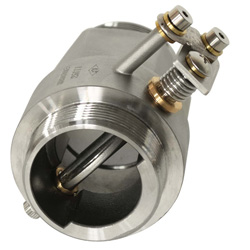



Find all of your laboratory and workplace safety supplies at Safety Emporium!
 Solution |
 Glossary Index |
 Spasm |
| MSDS Topics |
Free Sites | FAQ's | Regulations | Glossary | Software | Suppliers |
| Books | Forum | Poll | Fun stuff | Quiz | Store | |
| Understand your MSDS with the MS-Demystifier | Search ALL our MSDS info | |||||
A solvent is a substance that dissolves another substance or substances to form a solution (a homogeneous mixture). The solvent is the component in the solution that is present in the largest amount or is the one that determines the state of matter (i.e. solid, liquid, gas) of the solution. Solvents are usually, but not always, liquids. They can also be gases or solids.
The material dissolved in the solvent is called the solute. Together, the solvent and solute comprise the solution.

Store and dispense flammable liquids safely with flammable liquid safety cans from Safety Emporium.
Some examples:
The most common solvent most of us encounter is water (H2O). Liquid solutions having water as a solvent are called aqueous solutions. Water can dissolve many substances, but not all (see solubility).
Liquid solutions that do not have water as a solvent are called non-aqueous solutions. A broad and common class of non-aqueous solvents is called organic solvents; see the entry on organic for more about organic materials.

Organic solvents are usually flammable materials and may pose certain both physical and chemical hazards.
If your solvents are flammable, be aware that they can be ignited by the static electricity generated by pouring solvent from one container to another. When this potential exists, containers must be properly bonded and grounded; see the last three links under Further Reading (below) for more information.
Some typical examples of common organic solvents include:
| Common Name | Structural Formula | Flash Point |
|---|---|---|
| Acetone | (CH3)CO(CH3) | -17 oC (1 oF) |
| Ether (diethyl ether) | (CH3CH2)2O | -40oC (-40 oF) |
| n-Hexane | CH3CH2CH2CH2CH2CH3 | -23 oC (-10 oF) |
| Isopropanol (2-propanol) | (CH3)2CHOH | 11 oC (53 oF) |
| Toluene | C6H5CH3 | 4 oC (40 oF) |
Organic solvents which are volatile are called VOC's - volatile organic compounds. Not only are many VOC's flammable or capable of causing explosions, they are also usually not healthy to inhale. Examples include aromatics such a benzene and halogenated hydrocarbons such as carbon tetrachloride.
Because of these physical and health hazards, the use of organic solvents on an industrial scale leads to significant environmental and worker safety concerns as well as expensive purchasing and disposal costs. Over the past decade, there has been tremendous focus on green chemistry, an approach which focuses on production processes that reduce or eliminate the use and generation of hazardous substances. Green chemistry also emphasizes "atom economy" in which the quantities of the starting materials and byproducts of a reaction are reduced to a minimum. Green Chemistry is turning out to be a fantastic approach that often results in far lower costs of production while benefiting the environment and protecting workers. For more on Green Chemistry, see the Further Reading links below.
NOTE: We may collect a share of sales or other compensation from the links in the following list:

Vent your flammable storage safety cabinets safely with Safe-T-Vent thermally-actuated dampers from Safety Emporium.
If you are using a substance as a solvent, that generally means you'll be using a large quantity of it. Therefore, read the Safety Data Sheet before working with it so you'll know what to do in the event of spill or exposure to the material and to assess any potential health, fire or explosion hazards.
Pay close attention to selecting the proper gloves with a solvent. Regular latex gloves easily degrade in certain solvents and/or permit solvent and solute molecules to pass through.
Therefore, always be sure to use the proper gloves for the specific solvent you are working with. The SDS will typically recommend a specific type of glove in Section 8 (exposure controls/personal protection). In addition, there are a number of excellent glove selection guides on the web; see the Further Reading links in our PPE entry.
If you do not have adequate engineering controls such as a fume hood, a supplied air respirator or one with a properly selected organic vapor cartridge is a good idea. And always be sure to have proper ventilation. And, of course, flammability is a crucial concern as well.

Store your solvents safely with flammable storage safety cabinets from Safety Emporium.
See also: Concentration units, mole, nitrile, narcosis, personal protective equipment, solubility, solution.
Additional definitions from Google and OneLook.
Entry last updated: Monday, January 16, 2023. This page is copyright 2000-2025 by ILPI. Unauthorized duplication or posting on other web sites is expressly prohibited. Send suggestions, comments, and new entry desires (include the URL if applicable) to us by email.
Disclaimer: The information contained herein is believed to be true and accurate, however ILPI makes no guarantees concerning the veracity of any statement. Use of any information on this page is at the reader's own risk. ILPI strongly encourages the reader to consult the appropriate local, state and federal agencies concerning the matters discussed herein.